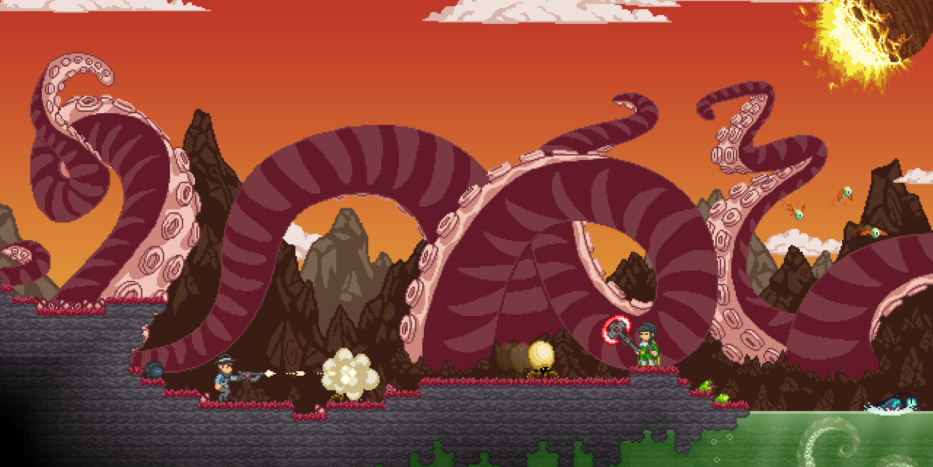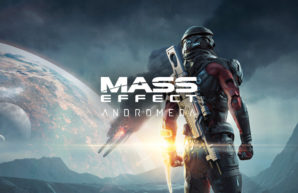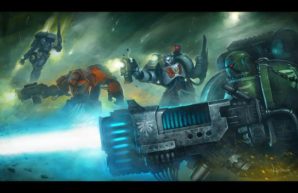With games like Terraria and Minecraft making massive strides for the crafting/survival sandbox genre, it was only a matter of time before the wave of clones, and possible successors, came along. The creative freedom to shape the world you live in to match your desires appeals to a wide audience, because the player is allowed to set the pace and style of their own experience.
The team at Chucklefish realizes the singular importance of that freedom and are working diligently to showcase it in their upcoming game, Starbound.
Sharing much more in common with the pixelated sidescroller, Terraria, Starbound offers up excellent retro pixel art and animations while expanding the scope significantly from that of its ancestor’s. In Terraria, the space in which the player can roam is limited by the oceans they will inevitably encounter in both directions. Starbound allows the player to completely loop around the world, taking anywhere from thirty minutes to three hours to complete the trip. This wide range comes from the fact that Starbound’s worlds are randomly generated down to the smallest detail.
Everything from the environment to the wildlife, and all the usable materials in-between, will have changed from the previous world you’ve played on. Got a craving for a barren, rocky world packed with giant octopus tentacles? It’s out there somewhere. If a player decides they’ve really had enough of a particular planet, they can channel their inner cosmic pioneer and set off in search of a new one.
With a name like Starbound, space travel had to be a given. The player begins the game with their very own spaceship, fleeing from a mysterious threat, and beams down to a wild planet to begin a new life. This threat isn’t just convenient back story for braving the elements, but the beginning of an adventure that the player can choose to pursue across the furthest reaches of the galaxy. Of course, ignoring it for pure planetary exploration is also an option.
At any time a player has the necessary fuel, they can beam up to their upgradeable spaceship and ride the hyper-currents to any of the innumerable planets they wish. Stars can make up unique constellations and each system within can be visited, each planet and moon explored. To ensure that you don’t get in over your head, planets are handily categorized by their danger. If a player is just starting out, it might not be wise to brave a volcanic world with particularly ravenous beasties that has a sky-high threat level. If you come across a specific planet that really speaks to you, you may claim it as your home planet and even share its galactic coordinates with friends so they can fly on over.
Planets can contain nearly anything and a player may never know what until they explore. There are six playable races, each with their own styles and abilities, and they too inhabit the galaxy. It’s entirely possible to find outposts, towns, and cities composed of these alien races. They may even have missions to embark on, provided you don’t intend on razing their settlements to the ground. There could be caves to explore for rare materials, or even various facilities like prisons or laboratories.
With all these exciting places to explore, and subsequently strip clean of all valuables, you might be wondering what can actually be done with all that junk. Fear not, the enormity of the game hasn’t damaged the quality of the crafting system. In fact, it’s nearly as expansive as the universe it exists within. The technology levels of what you can create are divided up into ten tiers. Starting at tier one, the tools and structures you’ll be able to throw together will be decidedly low tech. You’ll have to make due with crude melee weapons, pickaxes, and wooden huts. Things not dissimilar from what other games in this genre would give you. Eventually, as you tame science and nature alike, creations of much greater complexity will be possible. With energy weapons, computers, power armor, and even vehicles, you can become a ruler of worlds in no time at all.
At this point, you might be frothing at the mouth and throwing money at the screen (like me), but Starbound is currently in alpha. Fortunately, progress is being made at a blistering pace. Recently, the first crafting tier was completed, creating the framework for future crafting tiers to be finished more quickly. New creatures, environments, and items are being added constantly, further expanding the randomization pool and giving us truly unique worlds to enjoy. Bugs are being squashed in droves, improvements to the code and other systems like lighting have been accomplished in the past few days.
It’s difficult to put into words how exciting the concepts that Starbound flaunts are. A game like this is something that I, personally, have been waiting for ever since I experienced space stage in Spore and was left feeling that so much potential was untapped. Now that the dedicated development team at Chucklefish is on the case, lovingly crafting a game that they too have always wanted, I can rest easy knowing that it looks absolutely fantastic.
I’ll be diving into the beta, along with a few friends in multiplayer, as soon as it’s released sometime this year, and you can too. A Starbound pre-order is available at their website for a modest fee of $15. This gets you the amazingly atmospheric soundtrack as well as guaranteed beta access in the future. See you then, fellow starfarers.







